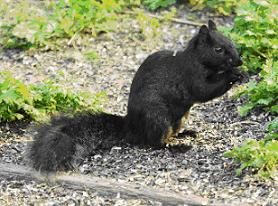A lot of people probably think that living in an urban environment means that we are far removed from nature. This is not true. Nature is all around us in Maspeth and Middle Village, although many times we simply fail to notice. Our parks and cemeteries provide refuge for creatures that would otherwise have been extirpated from our area long ago.
The first two neighborhood mammals profiled below belong to the rodent family, the third is a close relative, and the fourth is in a class by itself.
EASTERN GRAY SQUIRREL
The Eastern Gray Squirrel is the most common animal sighted in our backyards, parks and cemeteries. In winter, the squirrels mate and build their large nests in tree branches or cavities. They are completely vegetarian, mainly eating bulbs, seeds, nuts, acorns and berries. Sometimes, they’ll dig through a garbage can, but they are generally considered harmless. Avid gardeners who have to chase squirrels away in order to prevent them from digging up their flowers and vegetables may disagree with this statement, however. Ever plant something in your garden only to have it sprout up at your neighbor’s across the street? You can thank this bushy-tailed rascal for that. The black phase squirrel, increasingly more common in our area, is the expression of the recessive color gene of the gray squirrel, but both color variations are part of the same species.
EASTERN CHIPMUNK
The Eastern Chipmunk is a miniature squirrel that often feeds on acorns, hickory nuts, flower bulbs, fruits, and seeds, with an occasional slug or snail for variety. They build complex systems of underground burrows in which they store food and hibernate during colder months. They are most active during early morning and late afternoon hours. Both the male and female make loud calls that can be mistaken for bird chirps. They typically mate twice a year and produce two to five offspring between April and May, and then again between August and October. Hawks and feral cats are their main predators in this area.
EASTERN COTTONTAIL
Rabbits are small and cute and furry. They are also speed demons, able to run up to fifteen miles per hour, and jump distances of ten to fifteen feet. They were favorite targets of hunters many years ago, but the only predator they might have in this area nowadays is the red-tailed hawk, which will be profiled later in this article. These symbols of spring tend to be solitary, territorial and nocturnal, and are often visible only at the hours of dawn and dusk. Their diet is completely vegetarian; they’ll eat grass, clover, fruit and vegetables. During winter, they survive on twigs and bark. Their mating dance consists of boxing and jumping displays. The reason they are such prolific breeders is because the female can have three or four litters of up to nine babies per year, and are ready to reproduce when they are just three months old!
RACCOON
Believe it or not, the densest population of raccoons in the state of New York is found in the city of New York. Queens is home to a large number of them. One might think that our area would not provide a suitable environment for raccoons, as there are no streams running through here anymore. The belief that they wash their food is actually not true. Raccoons wet their food in order to enhance their sense of touch, which helps them to determine whether or not the food is edible. This is a highly adaptive creature. Their diet consists mainly of berries and insects. They present a danger to birds because they have a tendency to eat eggs and nestlings. The “masked bandits” also have learned to sometimes raid the garbage cans of people who live on the perimeters of cemeteries and parks, where they sleep in hollow tree dens. They will generally leave people alone, but have been known to scratch and bite. Raccoons are the most common wild carriers of rabies in the United States, so if you are aware of their presence near your home, keep an eye on your children and pets, and keep lids tightly secured on your garbage cans!
Where there are trees, you no doubt will find birds. Here are some common local birds that you may see in your daily travels throughout Maspeth and Middle Village.
RED-TAILED HAWK
You might think that being chased by dogs at Juniper Park is the squirrel’s worst nightmare, but they have more formidable enemies out there. New York’s most famous raptors are Pale Male and Lola, who have a nest on 5th Avenue overlooking Central Park. But Maspeth, Middle Village, and the rest of Queens host quite a number of sky hunters as well, the most common being the red-tailed hawk. Look up on any given day and you’ll probably see one or two circling overhead. They are easy to spot as their wingspan can reach up to four feet. They’ll land in just about any tree or on any telephone pole, but prefer those near open areas such as Juniper Park and St. John, Lutheran and Mount Olivet Cemeteries. From these, the bird can more easily spot potential prey. Their diet consists mainly of squirrels, chipmunks, pigeons, and the occasional rabbit, animals abundant in our area. They mate for life and build their large nests in tall trees and sometimes on the ledges of buildings. Some red-tails are migratory, others are not – it all depends on the food supply available in their territory.
DOWNY WOODPECKER
Ever walk through the park and hear fast-paced drumming above your head? That sound is coming from a woodpecker. We have several species of woodpecker in our area, but the most common is a year-round variety called Downy. The female, pictured, and the male look alike with the exception being that the male has a red spot at the back of his head that the female lacks. They are about six inches long. Their main sources of food are beetles, caterpillars and ants found under the bark of trees, hence the rapid-fire pecking. They may also supplement their diet with berries when bugs are scarce. They have been known to nest in our parks and cemeteries, and even in the trees that line our streets. A problem that people in other areas of the country have with woodpeckers is that they have been known to drill the sides of wooden houses. As most residents here opted for aluminum siding or brick-face long ago, that is not a major concern in our neighborhood.
RING-NECKED PHEASANT
If you visit an area cemetery and hear something that sounds like a swinging rusty gate, it could be just that. If it’s springtime, however, you may very well be hearing the call of a ring-necked pheasant. Early settlers to our area imported small flocks from Asia to serve as game, and the birds found refuge in every one of the graveyards of Maspeth and Middle Village. However, they can prove to be quite elusive. Amazingly, this large bird, which is more than two feet long from beak to tip of tail, can manage to disappear into the smallest bush. Stumbling upon one can be a thrilling surprise, but its ability to hide frequently leaves the observer feeling as though they witnessed some kind of magic trick. They consume mostly seeds and berries, but have also been known to eat large insects like grasshoppers, crickets and caterpillars. The best time to spot one is an hour after sunrise, when they come out to feed. The male is pictured; the hen is much plainer-looking in order to provide camouflage while nesting. The biggest threats to the nests are disturbance by people and destruction by feral cats. The raccoon, profiled previously, also sometimes presents a problem for them.
To finish off the list, we come to the most unusual example of local fauna.
ITALIAN WALL LIZARD
There are wild reptiles living right here in Maspeth, and I am not talking about alligators in the sewers (that’s just a legend, of course). A species called the Italian Wall Lizard has a stronghold on Mount Zion Cemetery. Their ancestral home is Italy. In 1967, a population was accidentally released in Garden City while in the process of being shipped to a pet store. They then spread like wildfire throughout parts of Queens. Italian Wall Lizards love to sit on top of rocks and bask in the sun, and have discovered that cemetery headstones can be ideal for that purpose. Their diet is comprised of insects. The lizards can grow to be 8 inches long, with their tails comprising much of that length. They hibernate in winter and become active during spring and summer months, when they breed by laying eggs. It’s a challenge to walk the paths of Mount Zion in July and August and not find them scurrying about, so if you go there, watch where you step!
This article was written to celebrate the wildlife that has survived encroachment upon its territory driven by our irrepressible need for development. Most of these creatures once ran freely all over Maspeth and Middle Village, but today desperately cling to our few remaining pockets of green space. We once had acre upon acre of pond and woodland; we have replaced those with miles of asphalt. It is important to remember that nature was present here long before any of our buildings. Preservation of our neighborhood shouldn’t stop with our architecture; it must extend to protecting our living environment as well. Planting more trees and developing more green spaces are parts of that effort and hopefully will bring us more in touch with those that reside in our own backyard.




